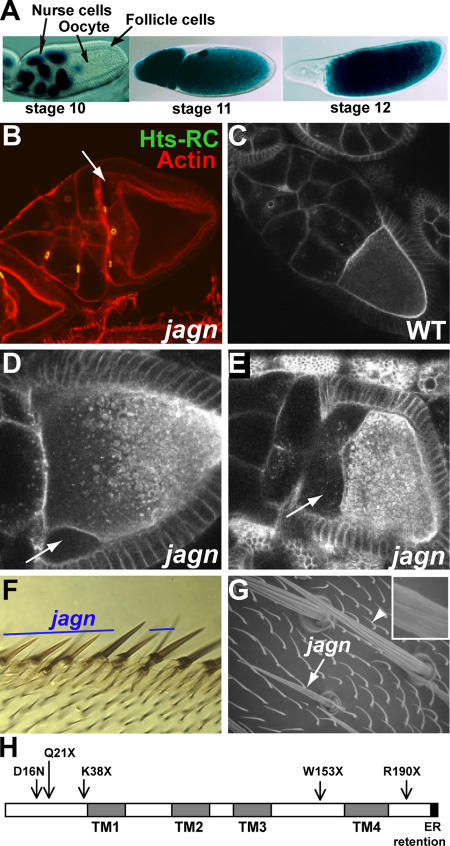Figure 1.
Jagunal is required for oocyte and bristle growth. (A) D. melanogaster egg chambers. Egg chambers before (stage 10), during (stage 11), and after (stage 12) nurse-cell dumping are shown with nuclear lacZ staining. Egg chambers are composed of germline cells (15 nurse cells and the oocyte) surrounded by somatic follicle cells. All egg chamber images are oriented with anterior to the left. (B) jagnQ21X GLCs were stained with rhodamine-conjugated phalloidin (red) to visualize F-actin and Hts-RC antibodies (green) to visualize ring canals. Mutant oocytes detach from nurse cells and follicle cells at the anterior region (arrow). (C–E) Live egg chambers were examined by Bsg-GFP fluorescence, which reveals plasma membranes and vesicles throughout the ooplasm. Wild-type egg chambers (C) and jagnQ21X GLCs (D and E) are shown. Mutant oocytes detach from nurse cells and follicle cells at the anterior region (D, arrow), and the defect becomes more severe as oogenesis proceeds (E, arrow). (F) jagnQ21X clones were marked by yellow (y −). Mutant wing anterior margin bristles are thinner and shorter than their wild-type counterparts. (G) A scanning electron microscope image of wild-type (arrowhead) and jagnQ21X (arrow) microchaetes. Mutant microchaetes are thinner and shorter than wild-type microchaetes, and have weak ridges (inset in G). (H) Domains of Jagunal and mutation sites in jagn alleles. Jagunal contains four predicted transmembrane domains (TMs) and a putative ER retention motif (dilysine motif) at the C-terminal end. Mutation sites in all jagn alleles were identified in the open reading frame of the jagunal gene (CG10978). jagnQ21X is the original mutation isolated from the Lehmann collection, and the other four alleles were isolated from a noncomplementation lethal screen.

